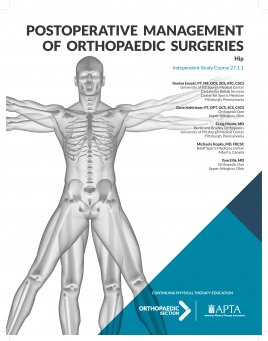
Hip
| Online Only | |
|---|---|
| APTA Orthopedics Member | $35 |
| Non-APTA Orthopedics Member | $50 |
Note: CEUs are not offered for this course.
Course Description
The range of surgical options available for individuals with hip pathology has continued to expand. Although total hip arthroplasty is a well-established technique for late-stage degenerative joint disease, arthroscopy and periacetabular osteotomy procedures are becoming more popular in the treatment of non-arthritic hip pain when conservative treatment is not successful. As surgical procedures for hip pathology advance, related rehabilitation protocols must evolve in parallel.
In this monograph, the authors first review anatomical considerations and pathological conditions of the hip joint. Specific pathologies include acetabular labral tears, femoral acetabular impingement, dysplasia, cartilage lesions, and osteoarthritis. The corresponding surgical options for each of these pathologies are then presented, and related postoperative rehabilitation concepts and their implementation throughout the course of care detailed. Only intervention techniques that provide an optimal evidence-based plan of care are included. In addition appropriate patient-reported outcome measures for specific surgical procedures of the hip joint are included.
Three case studies provide a chance for the reader to apply postoperative rehabilitation protocols in specific clinical situations. The first case involves a 29-year-old male referred to physical therapy 3 days after undergoing arthroscopic femoral osteoplasty and acetabular labral repair of his left hip. The second case is a 30-year-old female office manager who enters physical therapy 6 weeks after undergoing a periacetabular osteotomy surgical procedure of the left hip to address symptomatic joint dysplasia.
The third case is a 48-year-old male referred to physical therapy 4 weeks after undergoing a total hip arthroplasty procedure for the right lower extremity. This patient received a porous cementless femoral component paired with a cementless acetabular component. The authors have compiled a comprehensive and interesting monograph on the role of surgery and evidence-based rehabilitation for patients with hip pathology. The work coordinates the role of both types of medical care (surgical and rehabilitation) and highlights the important synergy between the two areas so the patient achieves optimal return to function.
Course Overview
Course Format: Online
Course Objectives
Upon completion of this monograph, the course participant will be able to:
- Describe anatomical characteristics of the hip joint as they relate to potential pathological conditions.
- Describe indications for surgical procedures of the hip joint.
- Understand current surgical techniques used to treat pathological conditions of the hip joint.
- Understand and apply concepts of tissue healing during rehabilitation.
- Describe intervention techniques used during rehabilitation after surgical procedures of the hip joint.
- Apply intervention techniques to develop an optimal evidence-based plan of care.
- Identify appropriate patient-reported outcome measures for specific surgical procedures of the hip joint.
Topics and Authors
Keelan Enseki, PT, MS, OCS, SCS, ATC, CSCS
Dave Kohlrieser, PT, DPT, OCS, SCS, CSCS
Craig Mauro, MD
Michaela Kopka, MD, FRCSC
Tom Ellis, MD
Add To Cart
Which version of the course would you like to purchase?
Members Only
You need to be a member to buy this course.
Join today to enjoy exclusive deals and prices on all courses.
Join Now